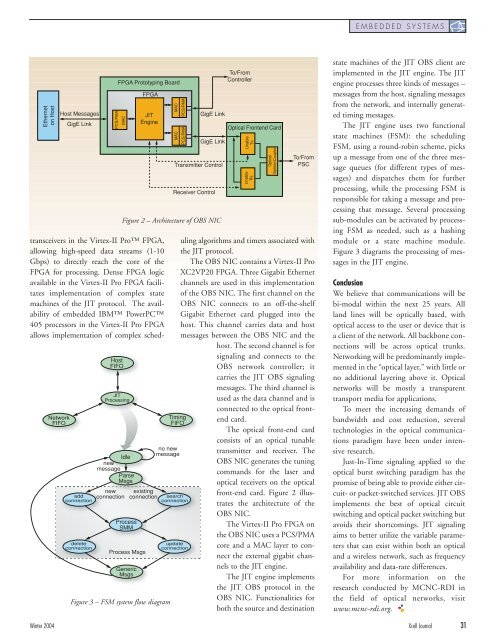Xcell Journal: The authoritative journal for programmable ... - Xilinx
Xcell Journal: The authoritative journal for programmable ... - Xilinx
Xcell Journal: The authoritative journal for programmable ... - Xilinx
You also want an ePaper? Increase the reach of your titles
YUMPU automatically turns print PDFs into web optimized ePapers that Google loves.
Ethernet<br />
on Host<br />
Host Messages<br />
GigE Link<br />
transceivers in the Virtex-II Pro FPGA,<br />
allowing high-speed data streams (1-10<br />
Gbps) to directly reach the core of the<br />
FPGA <strong>for</strong> processing. Dense FPGA logic<br />
available in the Virtex-II Pro FPGA facilitates<br />
implementation of complex state<br />
machines of the JIT protocol. <strong>The</strong> availability<br />
of embedded IBM PowerPC<br />
405 processors in the Virtex-II Pro FPGA<br />
allows implementation of complex sched-<br />
Network<br />
FIFO<br />
add<br />
connection<br />
delete<br />
connection<br />
PCS/PMA<br />
MAC<br />
Host<br />
FIFO<br />
JIT<br />
Processing<br />
Idle<br />
new<br />
message<br />
Parse<br />
Msgs<br />
new<br />
connection<br />
FPGA Prototyping Board<br />
FPGA<br />
JIT<br />
Engine<br />
MAC<br />
MAC<br />
PCS/PMA<br />
PCS/PMA<br />
GigE Link<br />
GigE Link<br />
Transmitter Control<br />
Receiver Control<br />
Figure 2 – Architecture of OBS NIC<br />
Process<br />
SMM<br />
Generic<br />
Msgs<br />
existing<br />
connection<br />
Process Msgs<br />
Timing<br />
FIFO<br />
no new<br />
message<br />
Figure 3 – FSM system flow diagram<br />
search<br />
connection<br />
update<br />
connection<br />
To/From<br />
Controller<br />
Optical Frontend Card<br />
Unable<br />
Tx<br />
Unable<br />
Rx<br />
uling algorithms and timers associated with<br />
the JIT protocol.<br />
<strong>The</strong> OBS NIC contains a Virtex-II Pro<br />
XC2VP20 FPGA. Three Gigabit Ethernet<br />
channels are used in this implementation<br />
of the OBS NIC. <strong>The</strong> first channel on the<br />
OBS NIC connects to an off-the-shelf<br />
Gigabit Ethernet card plugged into the<br />
host. This channel carries data and host<br />
messages between the OBS NIC and the<br />
host. <strong>The</strong> second channel is <strong>for</strong><br />
signaling and connects to the<br />
OBS network controller; it<br />
carries the JIT OBS signaling<br />
messages. <strong>The</strong> third channel is<br />
used as the data channel and is<br />
connected to the optical frontend<br />
card.<br />
<strong>The</strong> optical front-end card<br />
consists of an optical tunable<br />
transmitter and receiver. <strong>The</strong><br />
OBS NIC generates the tuning<br />
commands <strong>for</strong> the laser and<br />
optical receivers on the optical<br />
front-end card. Figure 2 illustrates<br />
the architecture of the<br />
OBS NIC.<br />
<strong>The</strong> Virtex-II Pro FPGA on<br />
the OBS NIC uses a PCS/PMA<br />
core and a MAC layer to connect<br />
the external gigabit channels<br />
to the JIT engine.<br />
<strong>The</strong> JIT engine implements<br />
the JIT OBS protocol in the<br />
OBS NIC. Functionalities <strong>for</strong><br />
both the source and destination<br />
EMBEDDED SYSTEMS<br />
state machines of the JIT OBS client are<br />
implemented in the JIT engine. <strong>The</strong> JIT<br />
engine processes three kinds of messages –<br />
messages from the host, signaling messages<br />
from the network, and internally generated<br />
timing messages.<br />
<strong>The</strong> JIT engine uses two functional<br />
state machines (FSM): the scheduling<br />
FSM, using a round-robin scheme, picks<br />
up a message from one of the three message<br />
queues (<strong>for</strong> different types of messages)<br />
and dispatches them <strong>for</strong> further<br />
processing, while the processing FSM is<br />
responsible <strong>for</strong> taking a message and processing<br />
that message. Several processing<br />
sub-modules can be activated by processing<br />
FSM as needed, such as a hashing<br />
module or a state machine module.<br />
Figure 3 diagrams the processing of messages<br />
in the JIT engine.<br />
Conclusion<br />
We believe that communications will be<br />
bi-modal within the next 25 years. All<br />
land lines will be optically based, with<br />
optical access to the user or device that is<br />
a client of the network. All backbone connections<br />
will be across optical trunks.<br />
Networking will be predominantly implemented<br />
in the “optical layer,” with little or<br />
no additional layering above it. Optical<br />
networks will be mostly a transparent<br />
transport media <strong>for</strong> applications.<br />
To meet the increasing demands of<br />
bandwidth and cost reduction, several<br />
technologies in the optical communications<br />
paradigm have been under intensive<br />
research.<br />
Just-In-Time signaling applied to the<br />
optical burst switching paradigm has the<br />
promise of being able to provide either circuit-<br />
or packet-switched services. JIT OBS<br />
implements the best of optical circuit<br />
switching and optical packet switching but<br />
avoids their shortcomings. JIT signaling<br />
aims to better utilize the variable parameters<br />
that can exist within both an optical<br />
and a wireless network, such as frequency<br />
availability and data-rate differences.<br />
For more in<strong>for</strong>mation on the<br />
research conducted by MCNC-RDI in<br />
the field of optical networks, visit<br />
www.mcnc-rdi.org.<br />
Winter 2004 <strong>Xcell</strong> <strong>Journal</strong> 31<br />
Optical<br />
Splitter/Coupler<br />
To/From<br />
PSC

















